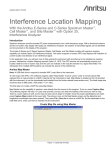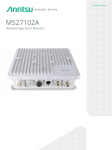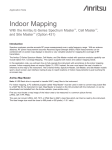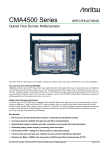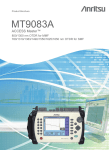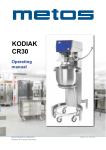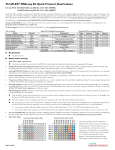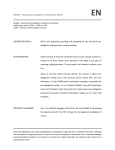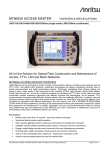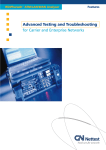Download Coverage Mapping with GPS Application Note
Transcript
Application Note Coverage Mapping with GPS With the Anritsu E-Series Spectrum Master™, Cell Master™, and Site Master™ (Option 431) Introduction Spectrum analyzers provide accurate RF power measurements over a wide frequency range. With an antenna attached, RF power measurement becomes Received Signal Strength (RSSI). RSSI measurements can be combined with on-screen map displays to become a very versatile solution for mapping the coverage of RF transmitters. The Anritsu E-Series Spectrum Master, Cell Master, and Site Master models with spectrum analysis capability can include Option 431, Coverage Mapping. This option supports the needs for both indoor and GPS coverage mapping. In this application note, you will learn how to fully operate the instrument with accordance to the coverage mapping with GPS process. This type of mapping requires Option 31, GPS. Instead of reporting your location to the instrument like in indoor mapping, the GPS receiver will automatically pinpoint your location relative to the map. Anritsu Map Master Note: A USB flash drive is required to transfer MAP (.map) files to the instrument. To coverage map with GPS, a PC software program called “Map Master” must be used in order to convert picture files captured from a map provider to a MAP (.map) file for the instrument to read. Map Master is located on the CD provided with the instrument, or can be downloaded and installed from the Anritsu website (www.anritsu.com). The ideal image size would be close to 666 pixels x 420 pixels (~1.6:1 ratio). The first step is to create a MAP file using Map Master. Map Master has the capability to capture a map directly from the source to the program. To do so, press Capture Map. The software program will load a 3rd party map, and you can enter the address of the area you wish to map. There is a zoom option as well, so the map and area can be larger or smaller. Once the proper specifications are made, press Capture Map located at the lower right. The picture is now on the Map Master screen and the latitudinal and longitudinal coordinates have been entered. Then press File | Save As to save as a MAP file. Set the destination to the USB flash drive, which can then be inserted into the instrument. Create Map file using Map Master Figure 1: Capturing the Map After pressing Capture Map, Map Master will load a 3rd-party map provider for easy screen-capturing. Figure 2: Saving the Map After pressing Capture Map on the bottom right, the map and coordinates will be sent to Map Master. Once done, simply save it to the USB flash drive. Getting Started Prior to conducting the coverage mapping survey, the analyzer itself must first be configured to properly measure the signals of interest. Knowledge of various parametrics such as anticipated signal strength and variation, potential presence of interfering signals, and noise sources should be used in determining analyzer settings. A brief summary of the main analyzer setups is shown below. However, the user may want to refer to the instrument user manual for more detailed guidance. 1. Bandwidth Parameters a.Resolution Bandwidth (RBW): minimum bandwidth over which one can separate two signals for viewing. The RBW can be decreased for viewing closely spaced signals at the expense of acquisition time. A low RBW is also advantageous in limiting noise distortion and resolution of low-level signals. b.Video Bandwidth (VBW): used for averaging and filtering noise. This is particularly useful in discerning low-level signals in the presence of noise. 2. Reference Level, Pre-Amplifier and Attenuator a.Reference Level: Input signal levels are reference to the top line of the graticule, known as the reference level. Depending on the amount of power anticipated in the signals to be measured, the reference level should be adjusted accordingly. b.Pre-Amplifier and Attenuator: In order to present the proper signal level to the analyzer detection circuits, pre-amplification or attenuation can be adjusted on the signal input. The attenuator can be automatically adjusted as a function of the reference level. In general, signals below -40 dBm can use the pre-amplifier while signals over -30 dBm should be attenuated. For example, if the reference level setting is 20 dBm, attenuation should be set to 50 dB for a mixer input of -30 dBm. 3. Detector Type a.Various detection circuits can be utilized. These include Peak, RMS, Negative and Sample. The type of detection is predicated on the user’s measurement needs. 4. Filtering a.Filtering should be used to measure signals in the presence of interferers. Filters can be added to the input of the analyzer to discriminate between wanted and unwanted signals, avoiding corruption of the measurement with adjacent high level signals. 5. Frequency a. Select frequency to be measured. To access the Coverage Mapping menu, either press the main menu icon SPA Coverage Mapping, or press the Shift + Measure (4) key, the More, and then the Coverage Mapping submenu key. 2 Note: For some instruments, this shortcut will not show up. Users can add it by pressing the Shift + Measure (4) key, the More, and then by holding the Coverage Mapping soft key for at least 3 seconds. Figure 3: SPA Coverage Mapping Setting Parameters Before you begin Coverage Mapping, the parameters should be adjusted appropriately. In order to do so, first access the coverage mapping menu. Once there, select Measurement Setup and then to edit the measurement settings, touch the RSSI button. The threshold RSSI values provide the user with easy visibility of the power level. Better than Excellent Between Excellent and Very Good Between Very Good and Good Between Good and Poor Worse than Poor Figure 4: RSSI The thresholds for the dBm values can be altered so the measurement indications on the map are colored appropriately for the expected signal levels. 3 Data Collection Another setting that can be personalized is the way the data is recorded. In the coverage mapping menu, select Point Distance/Time Setup. Once there, you can set the way it records data by either time or distance, and the intervals of which it collects the data. If the collection setting was set to time, the instrument will plot a data point whenever the time set in Repeat Time is reached. If the distance option was set, the user receives a data point whenever the allocated distance is attained. Figure 5: Data Collection Settings Turning on GPS In order to coverage map with GPS, Option 31 (GPS), is required. To turn the GPS on, press Shift + System (8), and then the GPS soft key. In the GPS sub-menu, you can turn the GPS on or off, view GPS info, change the GPS Voltage, or reset the GPS. Figure 6: System Menu Figure 7: GPS Sub-Menu The GPS sub-menu contains options essential for coverage mapping with GPS. 4 GPS Mapping To begin Coverage Mapping, you first must open the MAP (.map) file created earlier. Insert the USB flash drive into the USB port of the instrument. From there, at the Coverage Mapping menu, touch Save/Recall Points/ Map. In the Mapping Save/Recall submenu, touch Recall a Map. Find the file from the USB you inserted, and press Enter on the keypad. The map should now appear on the screen. If not done so already, the instrument will attempt to lock the GPS by tracking at least three satellites. Your location will then be set for you by the instrument relative to the map. Once that’s done, touch the Start Data Collection key to get started. The instrument will automatically update your location and record points as you move. Once all the needed points have been plotted, press Stop Data Collection to finish. Figure 8: Recalling a Map From the Coverage Mapping menu, select Save/Recall Points/Map and in the next menu, Recall a Map. Figure 9: Selecting MAP file Select the MAP (.map) file from the USB and press Enter on the keypad. 5 Figure 10: Position With the map on the screen, the instrument automatically pinpoints your location relative to the map. Figure 11: GPS Mapping When you press Start Data Collection, the instrument begins plotting the points. Once you are finished mapping, press Stop Data Collection to finish. 6 Saving the Data Collected Once Data Collection is complete, the data points can be saved as a KML file, a tab delimited text file (.mtd), and/ or a JPEG. When it is saved as a KML file, the data points can be later recalled by the instrument to be used once again, and when coverage mapped with the GPS option, the file can also be opened by Google Earth. For viewing the data collected however, it is recommended that the data be saved as a tab delimited file (.mtd). A tab delimited file can be opened with notepad or Excel for easy viewing and report generation. To begin, access the Mapping Save/Recall submenu from the Coverage Mapping Menu. From there, touch Save KML Points, Save Tab Delimited Points, or Save JPG. A pop-up save prompt comes up, where the filename and file type can be changed. Once finished, press enter on the keypad or touch screen to save. The file can then be copied to the USB, transferred and opened. Figure 12: Saving Data Points Access the Mapping Save/Recall submenu from the Coverage Mapping Menu. Figure 13: Saving the File Change the needed fields, and press Enter in order to save the file. 7 Analyzing the Data When saved as a tab delimited file (.mtd), the points recorded by the instrument can later be opened by a program such as Excel, to be viewed and analyzed. Once opened, looking at the file from top to bottom, the first things you see are the rows 1-16. It has basic information, such as the file mode, model, serial number, and date the mapping was done. The actual data below is divided into columns. Columns A-F is only relevant when coverage mapping with GPS, but the columns G-AE pertain to both coverage mapping methods. Column A- the point number Column B- the status of the GPS Column C- the longitude Column D- the latitude Column E- the UTC date Column F- the UTC time Column G- the system date Column H- the system time Column I- the mode the instrument was in Column J- what type of data was collected Column K- the values recorded by the instrument Columns L-AE corresponds to the setup of the instrument. The way that the setup is organized, columns N, P, R, and T have the actual setting values, and the preceding columns indicate the user of what exactly the following values mean. Column N- the frequency Column P- the RBW setting Column R- the VBW setting Column T- the detection type The columns U-AC shows the threshold values designated by the user earlier. You can look at the value placed in column K and refer to columns U-AC to determine the strength of the RF power measurement. At the very end, in the column AE, errors, if any, are listed. There are three possible values: ADC over range; saturation; and none. 8 The colors shown by the instrument provide easy viewing for the user when determining signal strength, but by viewing the file as a tab delimited file, the actual raw data can be seen. Figure 14: Viewing the Data The data can then be opened by other software programs for analysis and report generation. 9 Google Earth™ Figure 15: Google Earth With Google Earth, you can open a saved KML file transferred from the device to you computer. Simply doubleclick the KML file and Google Earth will run and show the points in a Digital Orthophoto Quadrangle (DOQ) format. You can click on the points to see both the colors for easy analyzing, as well as the more specific values given by a tab delimited file. To install Google Earth, go to the web site: http://earth.google.com/. Download the program and then install it to your computer. Additional help may be found through the Help pull-down menu. Conclusion Most wireless communications systems are designed to provide coverage over a predetermined area and not interfere with distant systems using the same frequencies. Coverage estimation software must make assumptions about loss due to terrain, buildings and other factors. If the assumptions are not accurate, the actual coverage of a system will differ from the design. Mapping the coverage with a precision receiver provides the ultimate proof and can help separate interference issues from signal strength problems. The Anritsu E-Series Spectrum Master™, Cell Master™, and Site Master™ models are powerful battery operated instruments that can support a wide range of signal types. With the addition of Option 431, and the power of GPS (Option 31), Coverage Mapping users can easily make signal strength measurements and create detailed maps and reports of system coverage. 10 Notes 11 Anritsu Corporation 5-1-1 Onna, Atsugi-shi, Kanagawa, 243-8555 Japan Phone: +81-46-223-1111 Fax: +81-46-296-1238 • U.S.A. Anritsu Company • Italy Anritsu S.p.A. Via Elio Vittorini, 129, 00144 Roma, Italy Phone: +39-06-509-9711 Fax: +39-06-502-2425 • Sweden Anritsu AB 1155 East Collins Boulevard, Suite 100, Richardson, TX, 75081 U.S.A. Toll Free: 1-800-ANRITSU (267-4878) Phone: +1-972-644-1777 Fax: +1-972-671-1877 Borgafjordsgatan 13, 164 40 KISTA, Sweden Phone: +46-8-534-707-00 Fax: +46-8-534-707-30 • Finland Anritsu AB • Canada Anritsu Electronics Ltd. 700 Silver Seven Road, Suite 120, Kanata, Ontario K2V 1C3, Canada Phone: +1-613-591-2003 Fax: +1-613-591-1006 • Brazil Anritsu Electrônica Ltda. Praça Amadeu Amaral, 27 - 1 Andar 01327-010 - Bela Vista - São Paulo - SP - Brasil Phone: +55-11-3283-2511 Fax: +55-11-3288-6940 Teknobulevardi 3-5, FI-01530 VANTAA, Finland Phone: +358-20-741-8100 Fax: +358-20-741-8111 • Denmark Anritsu A/S (for Service Assurance) Anritsu AB (for Test & Measurement) Kirkebjerg Allé 90 DK-2605 Brøndby, Denmark Phone: +45-7211-2200 Fax: +45-7211-2210 • Mexico Anritsu Company, S.A. de C.V. • Russia Anritsu EMEA Ltd. Representation Office in Russia Av. Ejército Nacional No. 579 Piso 9, Col. Granada 11520 México, D.F., México Phone: +52-55-1101-2370 Fax: +52-55-5254-3147 Tverskaya str. 16/2, bld. 1, 7th floor. Russia, 125009, Moscow Phone: +7-495-363-1694 Fax: +7-495-935-8962 • U.K. Anritsu EMEA Ltd. 200 Capability Green, Luton, Bedfordshire LU1 3LU, U.K. Phone: +44-1582-433280 Fax: +44-1582-731303 • France Anritsu S.A. 12 Avenue du Québec, Bâtiment Iris 1-Silic 638, 91140 VILLEBON SUR YVETTE, France Phone: +33-1-60-92-15-50 Fax: +33-1-64-46-10-65 • Germany Anritsu GmbH • United Arab Emirates Anritsu EMEA Ltd. Dubai Liaison Office P O Box 500413 - Dubai Internet City Al Thuraya Building, Tower 1, Suite 701, 7th Floor Dubai, United Arab Emirates Phone: +971-4-3670352 Fax: +971-4-3688460 • Singapore Anritsu Pte. Ltd. • India Anritsu Pte. Ltd. India Branch Office 3rd Floor, Shri Lakshminarayan Niwas, #2726, 80 ft Road, HAL 3rd Stage, Bangalore - 560 075, India Phone: +91-80-4058-1300 Fax: +91-80-4058-1301 • P. R. China (Hong Kong) Anritsu Company Ltd. Units 4 & 5, 28th Floor, Greenfield Tower, Concordia Plaza, No. 1 Science Museum Road, Tsim Sha Tsui East, Kowloon, Hong Kong, P.R. China Phone: +852-2301-4980 Fax: +852-2301-3545 • P. R. China (Beijing) Anritsu Company Ltd. Beijing Representative Office Room 2008, Beijing Fortune Building, No. 5 , Dong-San-Huan Bei Road, Chao-Yang District, Beijing 100004, P.R. China Phone: +86-10-6590-9230 Fax: +86-10-6590-9235 • Korea Anritsu Corporation, Ltd. 8F Hyunjuk Bldg. 832-41, Yeoksam-Dong, Kangnam-ku, Seoul, 135-080, Korea Phone: +82-2-553-6603 Fax: +82-2-553-6604 • Australia Anritsu Pty Ltd. Unit 21/270 Ferntree Gully Road, Notting Hill Victoria, 3168, Australia Phone: +61-3-9558-8177 Fax: +61-3-9558-8255 • Taiwan Anritsu Company Inc. 7F, No. 316, Sec. 1, Neihu Rd., Taipei 114, Taiwan Phone: +886-2-8751-1816 Fax: +886-2-8751-1817 60 Alexandra Terrace, #02-08, The Comtech (Lobby A) Singapore 118502 Phone: +65-6282-2400 Fax: +65-6282-2533 Nemetschek Haus, Konrad-Zuse-Platz 1 81829 München, Germany Phone: +49 (0) 89 442308-0 Fax: +49 (0) 89 442308-55 ®Anritsu All trademarks are registered trademarks of their respective companies. Data subject to change without notice. For the most recent specifications visit: www.anritsu.com 11410-00581, Rev. A Printed in United States 2010-08 ©2010 Anritsu Company. All Rights Reserved.












